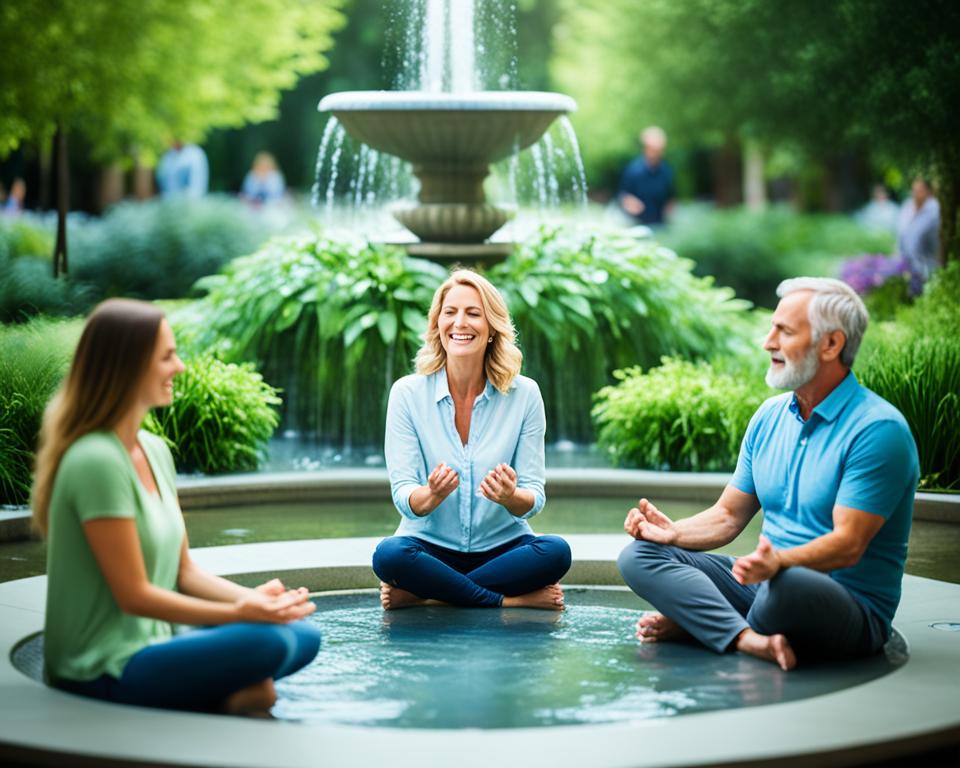In the dynamic landscape of group therapy, the incorporation of relaxation techniques has emerged as a transformative approach to empowering clients and fostering deeper therapeutic connections. This comprehensive guide delves into a diverse array of mindfulness exercises, deep breathing methods, progressive muscle relaxation, guided imagery, and meditation practices that can be seamlessly integrated into group therapy settings. By equipping therapists and group facilitators with a robust toolkit of stress management strategies and anxiety-reducing techniques, this article aims to help clients cultivate a profound sense of calm, focus, and self-awareness.
At the core of this guide lies the acknowledgment that creating a safe and supportive environment is paramount to the success of any group relaxation intervention. By delving into the nuances of adapting these techniques for diverse group dynamics and addressing the ethical considerations that underpin the facilitation of group relaxation sessions, this comprehensive resource empowers practitioners to enhance the overall therapeutic experience and empower their clients to develop sustainable self-care skills.
Read more interesting information at ::lesdamesmiami
Introduction to Relaxation Techniques in Group Therapy
Incorporating relaxation techniques for group therapy is a powerful approach to enhancing the therapeutic experience for both clients and facilitators. By integrating a variety of relaxation practices into group settings, therapists can help group members effectively manage stress and anxiety, cultivate present-moment awareness, and foster a deeper sense of unity and connection within the group.
Benefits of Incorporating Relaxation in Group Settings
The benefits of relaxation in group therapy are numerous and far-reaching. Relaxation techniques can help participants reduce physiological arousal, enabling them to better focus on the therapeutic process and engage more deeply with themselves and others. Additionally, the shared experience of relaxation can facilitate a sense of belonging and safety within the group, promoting open and honest communication.
Understanding the Importance of a Safe and Supportive Environment
Establishing a safe and supportive environment for group relaxation is crucial for the success of these practices. Group members must feel comfortable and encouraged to participate, free from judgment or pressure. By creating an atmosphere of trust and acceptance, therapists can empower group members to fully immerse themselves in the relaxation exercises, leading to more meaningful and transformative outcomes.
Mindfulness Exercises for Group Therapy
Incorporating mindfulness exercises into group therapy settings can be a transformative experience for participants. These practices help cultivate greater body awareness, acceptance, and stress reduction, providing a powerful tool for personal growth and healing. Two key mindfulness techniques that can be particularly impactful in group therapy are the Body Scan Meditation and mindful breathing practices.
Body Scan Meditation for Enhancing Awareness
The Body Scan Meditation is a mindfulness exercise that encourages participants to systematically focus their attention on different areas of the body, tuning in to physical sensations and cultivating a sense of present-moment awareness. By guiding group members through this practice, therapists can help them develop a deeper connection with their bodies, fostering acceptance and self-compassion. This exercise can be particularly beneficial for individuals struggling with stress, anxiety, or trauma, as it promotes a greater sense of grounding and embodiment.
Mindful Breathing Practices for Stress Reduction
Mindful breathing techniques are another powerful tool for group therapy settings. By directing attention to the natural flow of the breath, participants can learn to regulate their physiological responses, reducing stress and anxiety levels. Therapists can lead the group through various mindful breathing practices, such as diaphragmatic breathing or alternate nostril breathing, empowering group members to access these calming techniques as self-care strategies beyond the session. Incorporating mindful breathing exercises into group therapy can have a profound impact on the overall well-being and emotional regulation of the participants.
By integrating mindfulness exercises like the Body Scan Meditation and mindful breathing practices into group therapy, therapists can create a transformative experience for their clients. These techniques not only foster greater self-awareness and stress reduction but also cultivate a sense of unity and connection within the group, supporting the overall therapeutic process.
Deep Breathing Methods for Group Relaxation
In the context of group therapy, incorporating deep breathing methods can be a highly effective way to promote relaxation and inner calm among participants. Two key techniques that can be particularly beneficial are diaphragmatic breathing and alternate nostril breathing.
Diaphragmatic Breathing Techniques
Diaphragmatic breathing, also known as belly breathing or abdominal breathing, is a powerful technique that helps activate the parasympathetic nervous system, inducing a state of relaxation. By encouraging group members to breathe deeply, using the diaphragm rather than the chest, therapists can guide them in experiencing the numerous benefits of this breathing exercise, including reduced stress, improved oxygen intake, and a sense of emotional balance.
Alternate Nostril Breathing for Calming the Mind
Another deep breathing technique that can be particularly useful in group therapy settings is alternate nostril breathing. This practice involves gently closing off one nostril at a time, alternating between the left and right, while taking slow, deep breaths. This technique can help calm the mind, promote a sense of balance, and enhance overall feelings of relaxation. By guiding group members through this breathing exercise, therapists can encourage a state of focused attention and inner peace.
When incorporating these deep breathing methods into group therapy, it is crucial to provide clear, step-by-step instructions and to allow ample time for participants to fully engage with the practices. By helping group members cultivate proficiency in diaphragmatic breathing and alternate nostril breathing, therapists can empower them to access these powerful relaxation techniques beyond the group setting, ultimately supporting their overall well-being and mental health.
Progressive Muscle Relaxation Techniques
Progressive muscle relaxation (PMR) is a powerful technique that can be highly effective in group therapy settings. By systematically tensing and releasing different muscle groups, participants become more aware of their bodily sensations and can achieve a deeper state of relaxation. This section will provide guidance on facilitating guided progressive relaxation scripts that can be seamlessly incorporated into your group therapy sessions.
Guided Progressive Relaxation Scripts
One of the key benefits of using PMR in group therapy is the ability to guide participants through a structured relaxation script. These scripts lead individuals through a series of muscle tensing and releasing exercises, allowing them to actively engage with the process and observe the contrast between muscle tension and relaxation. By following the instructor’s cues, group members can learn to recognize and release physical stress, paving the way for a profound sense of calm and well-being.
When facilitating guided progressive relaxation scripts in a group setting, it is essential to provide clear and concise instructions, allowing ample time for participants to fully experience the tension and release in each muscle group. Encourage them to focus on the sensations in their bodies, and remind them to breathe deeply throughout the exercise. By creating a soothing and supportive environment, you can help group members maximize the benefits of these progressive muscle relaxation techniques and guided progressive relaxation scripts.
Guided Imagery for Stress Management
In the realm of relaxation techniques for group therapy, guided imagery stands out as a powerful tool for stress management. By leading participants on visualization exercises, therapists can transport them to peaceful, calming environments that foster a deep sense of tranquility and well-being.
Visualization Exercises for Relaxation
One of the key components of guided imagery is the use of visualization exercises. These practices encourage group members to imagine themselves in serene, natural settings, such as a tranquil beach, a lush forest, or a secluded mountain retreat. As participants immerse themselves in these imagined landscapes, they can experience a profound release of tension and a heightened state of relaxation.
Incorporating Nature Scenes and Peaceful Settings
The incorporation of nature scenes and peaceful settings into guided imagery scripts can have a remarkable effect on the relaxation experience. By tapping into the inherent calming and restorative properties of natural environments, therapists can help group members achieve a deeper level of mental and physical relaxation. Imagining the sights, sounds, and sensations of a serene natural setting can transport participants to a state of inner peace, allowing them to let go of stress and anxiety.
Through the skillful crafting and delivery of these guided imagery scripts, therapists can guide group members on a journey of relaxation, helping them manage stress, reduce tension, and cultivate a greater sense of inner calm. By harnessing the power of visualization and tapping into the restorative qualities of nature, this relaxation technique can be a valuable addition to the group therapy toolbox.
Meditation Practices for Group Therapy
Integrating meditation practices into group therapy sessions can be a powerful tool for cultivating present-moment awareness and inner calm among participants. One of the most widely used techniques in this context is mindfulness meditation, which encourages individuals to be fully attentive to the present moment, without judgment or preconceptions.
Mindfulness Meditation for Cultivating Present-Moment Awareness
Mindfulness meditation is a practice that invites group members to focus their attention on their breath, bodily sensations, or other aspects of their immediate experience. By guiding participants to gently redirect their attention whenever it wanders, the facilitator helps them develop greater self-awareness and the ability to remain grounded in the here and now. This heightened sense of presence can lead to a range of benefits, including reduced stress, improved emotional regulation, and enhanced overall well-being.
When leading mindfulness meditation exercises in a group therapy setting, it is crucial to provide clear instructions and create a safe, supportive environment that enables participants to fully immerse themselves in the practice. Facilitators should also be mindful of adapting the duration and intensity of the meditations to suit the needs and comfort levels of the group members.
By incorporating meditation practices for group therapy, such as mindfulness meditation for present-moment awareness, mental health professionals can empower their clients to cultivate a deeper sense of self-understanding and inner calm, ultimately enhancing the overall therapeutic experience.
Relaxation Techniques for Group Therapy
When incorporating relaxation techniques into group therapy, it’s essential to identify the most suitable methods based on the unique dynamics of each group. Factors such as group size, client demographics, and therapeutic goals should all be considered to ensure the greatest impact and engagement from participants.
Identifying Suitable Techniques for Different Group Dynamics
The selection of relaxation techniques should be tailored to the specific needs and preferences of the group. For instance, in a larger group, guided imagery exercises may be more effective in promoting a sense of calm and focus, as they allow participants to individually visualize soothing scenes. Conversely, in a smaller, more intimate setting, progressive muscle relaxation or mindfulness-based practices may foster a deeper level of self-awareness and interpersonal connection among group members.
Therapists should also consider the age, cultural backgrounds, and any special needs of the group when choosing relaxation techniques. Adapting the language, pacing, and sensory elements of the exercises can help ensure that all participants feel comfortable and engaged throughout the session.
Adapting Relaxation Methods for Varying Group Sizes
The size of the group can significantly impact the delivery and effectiveness of relaxation techniques. In larger groups, the facilitator may need to provide more structured guidance and use clearer, more concise instructions to ensure that everyone can follow along effectively. This may involve incorporating visual aids, such as or offering modifications for participants who require additional support.
Conversely, in smaller group settings, the facilitator can adopt a more personalized approach, allowing for more individual attention and fostering a greater sense of intimacy. This may involve incorporating more interactive elements, such as partner exercises or small-group discussions, to enhance the overall relaxation experience.
| Group Size | Recommended Relaxation Techniques | Adaptations and Considerations |
|---|---|---|
| Large Groups (10+) | Guided Imagery, Mindful Breathing, Group Body Scan | Provide clear, concise instructions; incorporate visual aids; offer modifications for individual needs |
| Medium Groups (6-10) | Progressive Muscle Relaxation, Mindfulness Meditation, Diaphragmatic Breathing | Balance individual attention with group facilitation; encourage group sharing and discussion |
| Small Groups (2-5) | Partner-based Exercises, Personalized Relaxation Scripts, Sensory-rich Experiences | Foster a more intimate, interactive environment; tailor techniques to individual preferences |
By carefully considering the group dynamics and adapting the relaxation methods accordingly, therapists can create a cohesive and engaging experience that helps all participants reap the benefits of these valuable practices.
Integrating Relaxation with Therapeutic Modalities
As mental health professionals seek to provide comprehensive and effective care, the integration of relaxation techniques with established therapeutic approaches has emerged as a powerful strategy. By seamlessly combining relaxation practices with evidence-based modalities, clinicians can deliver a more holistic treatment plan that empowers clients to develop a robust set of coping skills to manage stress, anxiety, and other mental health concerns.
Combining Relaxation with Cognitive-Behavioral Therapy (CBT)
The synergistic relationship between relaxation techniques and Cognitive-Behavioral Therapy (CBT) is particularly noteworthy. CBT, with its focus on restructuring negative thought patterns and promoting adaptive behaviors, can be significantly enhanced by the incorporation of relaxation exercises. For instance, by guiding clients through deep breathing, progressive muscle relaxation, or guided imagery practices, therapists can help them cultivate a state of calm and clarity, making it easier to identify and challenge maladaptive cognitions. This integration of relaxation with cognitive-behavioral therapy can lead to more effective emotion regulation, improved stress management, and sustainable behavioral changes.
Incorporating Relaxation into Psychoeducational Groups
Relaxation techniques can also be seamlessly integrated into psychoeducational group settings, where the goal is to provide clients with knowledge and strategies to manage their mental health. By incorporating relaxation into psychoeducational groups, facilitators can create a holistic learning environment that not only imparts theoretical understanding but also equips participants with practical tools for stress reduction and self-care. Group members can engage in mindfulness exercises, try out deep breathing techniques, or experience guided visualization, all while gaining valuable insights into the science and benefits of these practices. This approach fosters a sense of community, empowerment, and a well-rounded toolkit for managing mental health challenges.
| Combining Relaxation with CBT | Incorporating Relaxation into Psychoeducational Groups |
|---|---|
|
|
Creating a Relaxation-Friendly Environment
Crafting a serene and tranquil environment is pivotal to the success of group relaxation sessions. By setting up a calming and comfortable space, therapists can help group members fully immerse themselves in the relaxation exercises and experience the maximum benefits.
Setting Up a Calming and Comfortable Space
Thoughtful consideration should be given to the physical setting of the group therapy room. Soft, diffused lighting, a comfortable temperature, and cushioned seating arrangements can all contribute to a soothing ambiance. Encouraging group members to bring their own yoga mats or pillows can further enhance the sense of personal comfort and ownership within the space.
Using Sensory Elements to Enhance Relaxation
In addition to the physical environment, the strategic use of sensory elements can deeply enhance the relaxation experience for group members. Calming, nature-inspired soundscapes or gentle, soothing music can help participants focus inward and achieve a state of tranquility. Subtle, calming aromas from essential oils or diffusers can also serve as powerful triggers for relaxation, evoking a sense of peace and well-being.

By thoughtfully creating a relaxation-friendly environment, therapists can set the stage for group members to fully immerse themselves in the relaxation practices, maximizing the therapeutic benefits and fostering a sense of safety and comfort within the group setting.
Facilitating Group Relaxation Sessions
Fostering an environment where group members feel comfortable and empowered to engage in relaxation practices is crucial for the success of your group therapy sessions. By establishing clear guidelines and expectations, you can facilitate group relaxation sessions that encourage active participation and meaningful sharing of experiences.
Establishing Group Guidelines and Expectations
At the outset of your group relaxation sessions, it’s important to clearly establish group guidelines and expectations. This includes setting the tone for confidentiality, respect, and active engagement. Encourage group members to share their preferences and needs, ensuring that the relaxation exercises cater to the diverse experiences and comfort levels within the group.
Encouraging Participation and Sharing Experiences
To maximize the benefits of group relaxation, it’s essential to encourage participation and sharing of experiences among group members. Create opportunities for participants to share their thoughts, emotions, and insights during and after the relaxation exercises. This not only strengthens the sense of trust and connection within the group but also allows for valuable peer-to-peer learning and support.
Remember, the key to facilitating effective group relaxation sessions is to foster an environment where group members feel safe, supported, and empowered to explore and express their experiences. By establishing clear guidelines, encouraging active participation, and promoting the sharing of perspectives, you can help your clients derive the full benefits of these transformative relaxation practices.
Addressing Common Challenges in Group Relaxation
While group relaxation sessions offer numerous benefits, they can also present unique challenges that facilitators must be prepared to address. By understanding and anticipating these potential obstacles, therapists can create a more supportive and engaging environment for all participants.
Managing Distractions and Interruptions
One of the primary concerns in group relaxation is managing distractions and interruptions that can disrupt the flow and effectiveness of the exercises. Factors such as background noise, side conversations, or unexpected events can easily pull participants’ attention away from the present moment. To mitigate these issues, facilitators should establish clear guidelines for maintaining silence and minimizing disruptions during the relaxation activities. Additionally, they can strategically incorporate mindfulness techniques to help group members refocus their attention when their minds wander.
Accommodating Individual Needs and Preferences
Group relaxation sessions must also account for the diverse needs and preferences of the participants. Individuals may have varying levels of comfort, physical abilities, or personal preferences when it comes to the relaxation techniques. Facilitators can address this challenge by offering modified versions of the exercises, providing alternatives, and encouraging participants to engage in the practices in a way that feels most natural and comfortable for them. By fostering an inclusive and adaptable environment, therapists can ensure that all group members can fully participate and benefit from the relaxation experience.
Evaluating and Monitoring Progress
Ensuring the long-term effectiveness of group relaxation sessions requires continuous evaluation and monitoring. By incorporating participant feedback and adjusting techniques accordingly, therapists and facilitators can refine the relaxation practices to better meet the evolving needs of the group. Additionally, measuring the impact of these interventions through a variety of assessment methods can provide valuable insights into the efficacy of the relaxation program.
Incorporating Feedback and Adjusting Techniques
Regularly soliciting feedback from group members is essential for evaluating and monitoring progress in group relaxation. Therapists should create opportunities for participants to share their experiences, comfort levels, and suggestions for improvement. This input can then be used to incorporate feedback and adjust techniques as needed, ensuring the relaxation practices remain engaging, relevant, and tailored to the group’s preferences.
By actively listening to group members and making adaptations based on their feedback, facilitators can continuously improve the effectiveness of relaxation interventions and enhance the overall therapeutic experience.
Measuring the Effectiveness of Relaxation Interventions
To fully assess the impact of the relaxation techniques used in group therapy, it is crucial to implement strategies for measuring the effectiveness of relaxation interventions. This can involve the use of client self-reports, behavioral observations, and outcome-based assessments that track changes in stress levels, anxiety, focus, and overall well-being over time.
By gathering data on the physiological, cognitive, and emotional responses of group members, therapists can evaluate and monitor progress in group relaxation and make informed decisions about refining or expanding the relaxation program. This data-driven approach helps ensure that the group relaxation sessions continue to provide meaningful and impactful therapeutic benefits.

Ethical Considerations and Professional Boundaries
When facilitating group relaxation sessions, it is crucial for therapists and facilitators to uphold the highest standards of ethical conduct and maintain clear professional boundaries. This final section addresses the key ethical considerations that must be prioritized to ensure the safety and well-being of all group members.
Maintaining Confidentiality and Privacy
Protecting the confidentiality and privacy of group participants is a fundamental ethical obligation. Therapists must take proactive measures to safeguard any sensitive information shared during the relaxation sessions, including adhering to relevant privacy laws and regulations. This may involve securing the meeting space, obtaining informed consent, and emphasizing the importance of respecting the privacy of fellow group members.
Setting Appropriate Limits and Boundaries
Establishing and maintaining appropriate limits and boundaries is essential for creating a safe and trustworthy environment for group relaxation. Therapists should clearly communicate their role, the scope of the sessions, and any restrictions or expectations regarding physical contact, personal disclosures, and the therapeutic relationship. By setting these boundaries, practitioners can foster an atmosphere of trust and respect, ensuring that all participants feel secure and empowered to engage in the relaxation exercises.
Adhering to ethical standards and professional guidelines is crucial for facilitating group relaxation sessions that uphold the well-being and safety of all participants. By maintaining confidentiality, setting appropriate limits and boundaries, and prioritizing the needs of the group, therapists can create a nurturing environment that enables clients to fully benefit from the relaxation techniques and cultivate lasting self-care skills.
Conclusion
In this comprehensive guide, we have explored a wide range of relaxation techniques for group therapy that can be effectively incorporated into mental health treatment settings. From mindfulness exercises and deep breathing methods to progressive muscle relaxation, guided imagery, and meditation practices, therapists and group facilitators now have a rich toolkit of evidence-based strategies to help clients manage stress, reduce anxiety, and cultivate a state of calm and focus.
By creating a safe and supportive environment, adapting techniques to different group dynamics, and adhering to ethical considerations, practitioners can enhance the therapeutic experience and empower group members to develop sustainable relaxation and self-care skills. This guide serves as a valuable resource for mental health professionals interested in integrating relaxation techniques into their group therapy practice.
In summary, the key points covered in this article include the numerous benefits of incorporating relaxation practices in group therapy, the importance of establishing a safe and supportive environment, and a detailed exploration of various relaxation techniques such as mindfulness, deep breathing, progressive muscle relaxation, guided imagery, and meditation. By leveraging these evidence-based strategies, therapists can help their clients achieve greater emotional regulation, reduce stress and anxiety, and cultivate a greater sense of well-being, ultimately enhancing the overall effectiveness of the group therapy experience.



